Analysis: Will the Blues' backs ever get the ball?

The Blues 24-22 loss at the hands of the Crusaders was promising and heartbreaking at the same time. The Blues were dominant at times and had the Crusaders there for the taking multiple times, but failed to capitalise making this a hard pill to swallow given they had the chance to take down the defending champions.
What did we see from the Blues for the first time under new head coach Leon Macdonald, and where are the improvement areas for the side?
Compounding mistakes
After having only three points to show from two early entries into the Crusaders’ 22, the Blues quickly conceded the first try of the match on the back of compounding mistakes.
Defending on halfway, the Blues conceded a line break that was more about disjointed defence than anything special the Crusaders did.
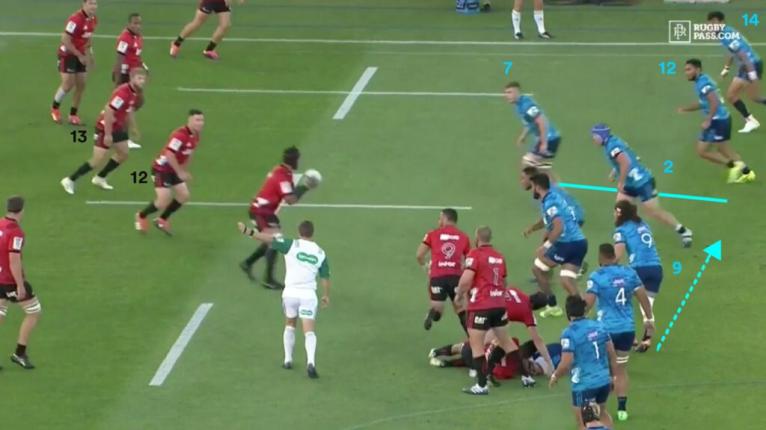
 The Crusaders have a five-on-four advantage down this left side, with the only free man being George Bridge (circled) on the touchline.
The Crusaders have a five-on-four advantage down this left side, with the only free man being George Bridge (circled) on the touchline.
With Jonathan Ruru (9) playing sweeper, a passive up-and-out defence can push this ball to the sideline and shut this down without having to do anything special but see each pass go wider without committing any defenders.
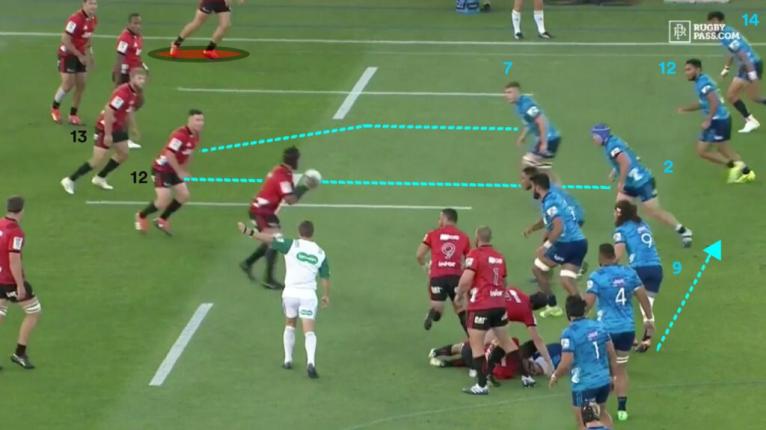
Dalton Papalii (7) is bringing more line speed than any of his teammates with alignment on Braydon Ennor (13), however, he changes his angle in search of a dominant tackle on Ryan Crotty (12), who just lets the ball fly across his face.
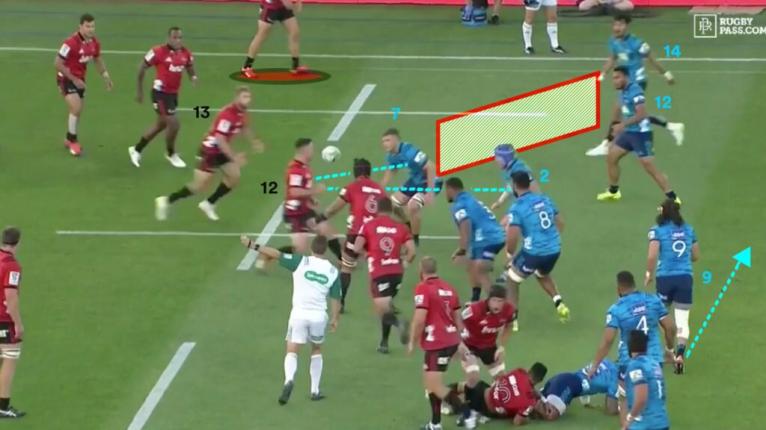
There is no need for Papalii to jam in, and it allows Ennor to burst through the line in the vacant hole left behind. The young Blues flanker’s over-eagerness to put a shot on illustrates how the Blues don’t always sing from the same song sheet, and perhaps shows a lack of communication on this occasion.
The lesson for Papalii is understanding situational defence and leverage, knowing when and when not to rush, and how to play non-committal coverage to keep your line intact and reduce the numbers advantage. He might have a license to rush and bring pressure from anywhere, but the decision to take a man already covered wasn’t wise.
The Blues do scramble and force a knock-on in the tackle, winning a scrum on their own 10-metre line. From there, Ruru’s exit kick is charged down and the Crusaders win an attacking scrum in prime real estate.
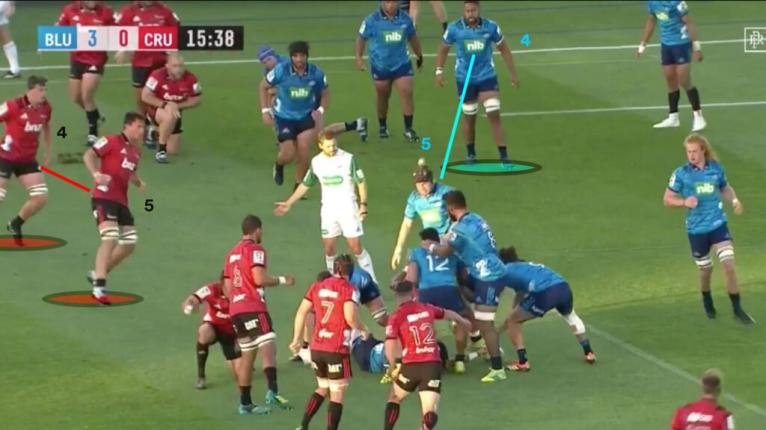
Here are both second rows before the charge down. Both have the same job of getting up from the scrum. The Crusaders pair is there ready to bring pressure but only one Blues lock, Josh Goodhue (5), is positioned ready to shield.
The Crusaders just work harder at the little things off the ball to create opportunities and Quinten Strange (5) is able to charge unobstructed and win possession.
The last Blues blunder is Michael Collins’ dropped ball on the cross-kick from the resulting scrum which gifts Crusaders winger Manasa Mataele five points. A slew of mental and execution errors compounding ended in five Crusaders points when the Blues had all the control.
8-man rugby
For all the talent the Blues have at their disposal, this was almost 8-man rugby for 80-minutes.
Leon Macdonald’s transformation of the Blues won’t happen overnight and against the Crusaders they played pretty conservatively but were plagued by execution and pressure in the red zone in the first half.
The Blues had five entries with possession into the Crusaders’ 22 in the first half and only came away with three points, a measly return of 0.6 points per entry.
Almost every entry was characterised by carries, carries and more carries. The pack tried to bully their way over and were limited, with the likes of Matt Todd and Scott Barrett attacking the breakdown and the ball carrier and winning crucial turnovers.
In the second half, they tried more of the same and were able to change their fortunes, scoring three tries from five 22-visits for a return of 3.8 points per entry.
A dominant second half doesn’t make up for a poor first one, but the Blues did push the Crusaders all the way in the game. In these tight games, clinical details matter and all the little moments make the difference. A full-80 minute performance is required to beat the Crusaders.
Too much Akira-ball?
Rieko Ioane’s 12-metres on four carries is criminal underuse of one of the game’s premier attacking weapons.
Having an 8 that likes to carry and a 9 that likes to run is bad news for the backs. A massive 60 percent of the Blues’ scrum plays inside the Crusaders’ half were carries off the back for Akira Ioane.
His younger brother had just two designed plays off set-piece, carrying down the 10 channel twice, and got the ball just once on his left flank in the game.
From 17 attacking set-piece opportunities in the opposition half, the Blues attacked wide just once on the first phase. There weren’t many setups for second or third phase stings either, instead, using the forwards around the corner continuously.
Macdonald’s fingerprints
The Blues’ shape in the middle third has changed under Leon Macdonald. They have adopted Tasman’s 5-3 forward split to set up a large open side with a central two-man pod and a midfielder out the back, but this was only visible briefly as there wasn’t much continuity in phase play in this area of the field.
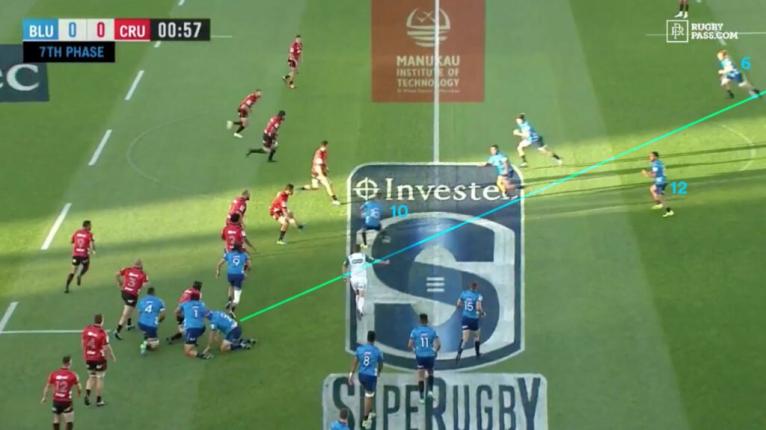
This is generally going to be the ‘backs playground’, with a license to play with some width and work to open up the opposition, but when they did have possession there, we saw the depth issues that plagued the Blues last year, with extremely deep outsides that aren’t bringing any pace onto it.
The first visible sign of Macdonald’s genius play-designs was a halfback-wrap out of a kick formation in the second half, using the 10 from a deep kicking option as an inside option of the runner.
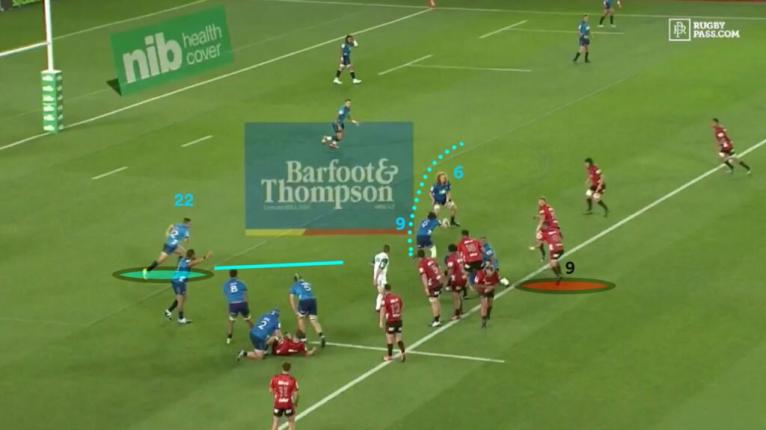
The Blues setup for a clearing kick from Harry Plummer (22), but Ruru (9) feeds Tom Robinson (6) and performs a wrap around, pulling some the Crusaders’ interior defenders wider.
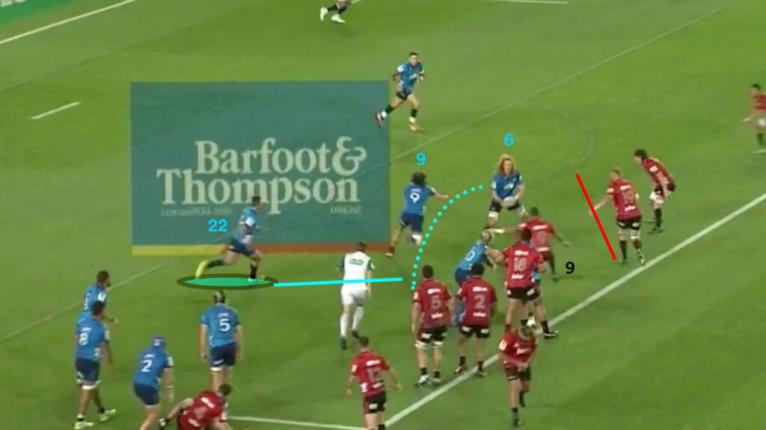
Ruru’s line pulls Luke Romano (19) wider, while Bryn Hall (9) identifies Plummer and points him out. With Romano pushing wider, Robinson takes the one-on-one matchup with Hall and pokes through before getting an offload away to Plummer at pace who streaks away downfield.
If the Blues want to ignite their backs more often, the balance of the side might be better suited having Sam Nock starting at halfback and someone like Jordan Trainor at fullback. The most experienced 10 on the roster at Super Rugby level, Stephen Perofeta, was not in the matchday-23.
Last year Perofeta proved to be a dangerous running and ball-playing threat capable of playing direct and unlocking defensive lines, something that Otere Black didn’t do yesterday in his 52-minute performance.
They physically matched and bettered the Crusaders, but were outsmarted and outplayed by small margins. It wasn’t the prettiest game by the Blues but ultimately they did have the chance to win and fought to the end, proving they will be a much tougher ask to overcome than last year.






































Comments on RugbyPass
Must be something when you are only 19 y.o and both NZ and France want you. Btw he wasn’t the only new caledonian in french U20 as Robin Couly also lived in Noumea until 17. Hope he’s successful wherever he chooses to play.
7 Go to comments“Several key players in the Stade Rochelais squad are in their thirties” South Africans are going to hate the implications of that comment!
3 Go to commentsI know Leinster did a job on La Roche but shortly after HT Leinster were 30-13 ahead of them and at a similar time Toulouse were trailing Exeter. At 60 mins Leinster were 27 ahead but after 67 mins Toulouse were only 19 ahead before Exeter collapsed. That’s heavier scoring by Leinster against the Champions. I think people are looking at Toulouses total a little too much. I also think Northhampton are in with a real chance, albeit I’d put Leinster as favourites. If Leinster make the final I expect them to win by more than ten and with control.
3 Go to commentsHey Nick, your match analysis is decent but the top and tail not so much, a bit more random. For a start there’s a seismic difference in regenerating any club side over a test team. EJ pretty much had to urinate with the appendage he’d been given at test level whereas club success is impacted hugely by the budget. Look no further than Boudjellal’s Toulon project for a perfect example. The set ups at La Rochelle and Leinster are like chalk and cheese and you are correct that Leinster are ahead. Leinster are not just slightly ahead though, they are light years ahead on their plans, with the next gen champions cup team already blooded, seasoned and developing at speed from their time manning the fort in the URC while the cream play CC and tests. They have engineered a strong talent conveyor belt into their system, supported by private money funnelled into a couple of Leinster private schools. The really smart move from Leinster and the IRFU however is maximising the Irish Revenue tax breaks (tax relief on the best 10 years earnings refunded at retirement) to help keep all of their stars in Ireland and happy, while simultaneously funding marquee players consistently. And of course Barrett is the latest example. But in no way is he a “replacement for Henshaw”, he’s only there for one season!!! As for Rob Baxter, the best advice you can give him is to start lobbying Parliament and HMRC for a similar state subsidy, but don’t hold your breath… One thing Cullen has been very smart with is his coaching team. Very quickly he realised his need to supplement his skills, there was talk of him exiting after his first couple of years but he was extremely shrewd bringing in Lancaster and now Nienaber. That has worked superbly and added a layer that really has made a tangible difference. Apart from that you were bang on the money… 😉😂
3 Go to commentsNot sure exactly what went wrong for him at Glasgow but it’s pretty clear he ain’t Franco’s cup of tea. Suspect he would have been better served heading out of Scotland around the same time as Finn, Hoggy and Jonny!
1 Go to commentsBulls disrespected the Northampton supporters and the competition. Decide quickly, fully in or out.
25 Go to commentsI wonder if Parling was ever on England’s radar as a coach? Obviously Borthwick is a great lineout coach, but I do worry he might be taking on too much as both head coach and forwards coach.
1 Go to commentsJason Jenkins has one cap. When Etzebeth was his age he had over 80 caps. Experience matters. He will never amount to what Etzebeth has because he hasn’t been developed as an international player.
2 Go to commentsSays much about the player picking this gig over the easier and bigger rewards offered to him in Japan. Also says a lot about the state sanctioned tax benefits the Irish Revenue offers pro rugby players, with their ten highest earning years subject to an additional 40% tax relief and paid as a lump sum, in cash, at retirement. Certainly helps Leinster line up the financial ducks in a row to fund marquee signings like this!!! No other union anywhere in world rugby benefits from this kind of lucrative financial sponsorship from their government…
5 Go to commentsTrue Jordie could earn a lot more in Japan. But by choosing Leinster he’ll be playing with 1 of the best clubs in the world and can win a champions cup and URC…..
6 Go to commentsThanks for that Marshy, noticed you didn't say who is gonna win it. We know who ain't gonna win it - your Crusaders outfit. They've gone from having arguably the best Super Rugby first five ever, to having a clutch of rookies. Hurricanes all the way!
1 Go to commentsGeez you really have to question the NRLs ability to produce players of quality. Its pathetic. Dont the 25mil in Aus produce enough quality womens players. Sad.
1 Go to commentsBulls fan here, and agree 100% with the conclusion (and little else) of this article. SA sides should absolutely f-off from the champs cup until we get fair scheduling, equal support for travel arrangements and home semis. You know, like all the european teams get.
25 Go to commentsI’m yet to see why Grace would be an ABs contender. He’s pedestrian and lacks the dominance required of a top flight 8.
11 Go to commentsGee my Highlanders were terrible. They have gone backwards since the start of the season. The trouble began when we left Millar behind to prep as the 10 against the Brumbies and he was disconnected from the team that came back from Aussie. We rested Patchell for that game and we blew an avalanche of ball in good attacking positions in the 1st half. Against the Rebels we seem to of gone into a pod system with forwards hanging off from the breakdown leaving Fakatava to secure our ball!
80 Go to commentsPot Kettle, the English and French teams have done it for years.
25 Go to commentsHas virtually played every minute of previous games. Back row of Li Lo Willie , Grace and Blackadder would be the 1. Crusaders issue is a very average 1st 5 who cannot run. Kicking in general play is also below par They need to put Yong Kemara in. He must have so.e talent for them to bring him down from Waikato. Hoehepa would struggle to play in so.e club sided
11 Go to commentsI hope this a good thing making all these changes!
3 Go to commentsThe Hurricanes are good, especially with a decent coach now. However, let’s be real, the Crusaders and Chiefs are clearly a good degree weaker without the players they’ve lost overseas now. The Canes lost one player. It’s also why the aussie teams ‘seem’ to be stronger.
9 Go to commentsOr you could develop your own players instead of constantly taking from the SH competition and weakening it in the process? With all the player and financial resources these unions have compared to SH countries you’d think they could manage that, or is weakening the SH comps and their national sides an added bonus? Probably.
3 Go to comments